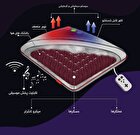Iran’s Light-Weight Panels Made of Construction Waste Resistant to Quake, Fire

“We were looking for implementation of a plan that could reduce the construction costs and return the construction debris to the production cycle and use them in construction activities again,” Mohsen Kheirmand Parizi, a manager of one of the technological units stationed at the accident center of Islamic Azad University, told ANA.
Noting that the reuse of debris leads to a 30% reduction in construction costs, he said, “We used the construction waste in the panels of structures, and due to their lightness, they can reduce a large part of the structure's weight.”
Kheirmand Parizi mentioned the high resistance of against fire and earthquake compared to existing materials among other advantages of these panels, saying, “Since these panels are produced in an integrated manner, they have a better structural impact.”
In a relevant development in July, a group of engineers from a technological company in Iran designed and manufactured earthquake-resistant prefabricated houses which are movable and the safest place during tremors.
“One of the main needs of Iran is the light structures since these frames, in addition to resistance to earthquake reduce the weight of the structure by 50%,” said Ali Akbar Khademi, the director of business, design and development of the technological company.
He mentioned economic efficiency as another advantage of the plan, saying, “The price of these structures is 20% lower than traditional structures, while unlike prefabricated structures including canopies and the like, whether in concrete or metal form, these structures are able to save energy.”
“In the past, we used kenaf in production of these structures which caused the structure to crack; therefore, we used a type of wall based on nanotechnology to solve this problem in production of these structures,” Khademi said.
4155/v
























